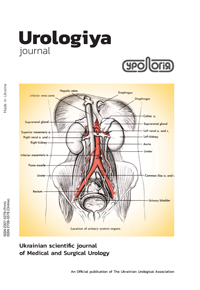Activation of persistent pathogenic microflora after ascending pyelolithotripsy and the recurrence rate of nephrolithiasis
DOI:
https://doi.org/10.26641/2307-5279.26.2.2022.279553Keywords:
recurrence of nephrolithiasis, persistent pathogenic microflora, pyelolithotripsyAbstract
We’ve studied the activation of persistent pathogenic microflora in 28 patients after retrograde pyelolithotripsy and the frequency of recurrence of kidney stones during the year under the conditions of traditional drug treatment in the early and late postoperative periods. We’ve studied the recurrence of kidney stones during the year under conditions of use in another group of patients (26 patients), in addition to traditional drug treatment, phytouroantiseptic (herbal extract BNO 1045). It has been confirmed that persistent pathogenic microflora is found in the structures of urinary stones, which is released after operative crushing of stones and reverses into active forms that are insensitive to the main groups of antibiotics, which long-term support a chronic inflammatory process in the kidneys, and is the cause of exacerbation of chronic pyelonephritis and relapse. It has been proven that the use of a phytouroantiseptic (herbal extract BNO 1045) in the complex treatment is the effective method for eliminating the infectious and inflammatory process in the kidneys caused by persistent pathogenic microflora, for decreasing the level of uric acid in the blood and normalization of urine’s pH, which leads to effective prevention of stone relapse.
References
Bukharin, O. V. (1999). Persistence of pathogenic bacteria. Medicine.
Choong, S. K. S., Hallson, P., Whitfield, H. N. & Fry, C. H. (1999). The physicochemical basis of urinary catheter encrustation. Br J Urol Int, 83, 770-775.
https://doi.org/10.1046/j.1464-410x.1999.00014.x
Choong, S. K. S., Wood, S., Fry, C. H., & Whit-field, H. N. (2001). Catheter associated urinary tract infection and encrustation. Int J Antimicrob Agents, 17, 305-310. https://doi.org/10.1016/s0924-8579(00)00348-4
Falagas, M. E., & Gorbach, S. L. (1995). Practice guidelines: urinary tract infections. Infect. Dis. Clin. Pract, 4, 241-256. https://doi.org/10.1097/00019048-199507000-00001
Morris, N. S. & Stickler, D. J. (2001). Does drinking cranberry juice produce urine inhibitory to the de¬velopment of crystalline, catheter-blocking Pro¬teus mirabilis biofilms? Br J Urol Int, 88, 192-197. https://doi.org/10.1046/j.1464-410x.2001.02248.x
Romanova, Yu. M., Tiganova, I. G., Khmel’, I. A., Alekseeva, N. V., Stepanova, T. V., Shevlyagi¬na, N. V., Didenko, L. V., Goryachev, S. N., & Ginzburg, A. L. (2011). Biofilms of Burkholderia cepacia: Characteristics of mutants with modified formation capacity. Mol. Genet. Mikrobiol. Virusol. 26(3), 3-10. https://doi.org/10.3103/s0891416811030037
Suleimanov, S. I., Kadyrov, Z. A., Istratov, V. N., & Romashvili, V. Sh. (2010). The role of the infectious factor in the pathogenesis of urolithiasis. Clinical laboratory diagnostics, 7, 18-23.
Ukhal, M., & Borisov, A. (2002). The role of activated by accompanying inflammation in kidneys secretory Ig a in the development of urolithiasis. 26-Congress of the Societe Internationale Urologie. SIU. Stocholm. 312.
Vashchula, V. I., Lish, E. Ya., & Stankevich, S. I. (2007). Infection in the etiopathogenesis of urolithiasis. Medical news, 11.113-118.
Downloads
Published
Issue
Section
License
Стаття повинна мати візу керівника та офіційне направлення від установи, з якої виходить стаття (з круглою печаткою), і вказівкою, чи є стаття дисертаційною, а також у довільній формі на окремому аркуші - відомості про авторів (прізвище, ім’я, по батькові, посада, вчений ступінь, місце роботи, адреса, контактні телефони, E-mail).
Стаття повина бути підписана всіма авторами, які укладають з редакцією договір пропередачу авторських прав (заповнюється на кожного автора окремо з оригінальним підписом). За таких умов редакція має право на її публікацію та розміщення на сайті видавництва.

